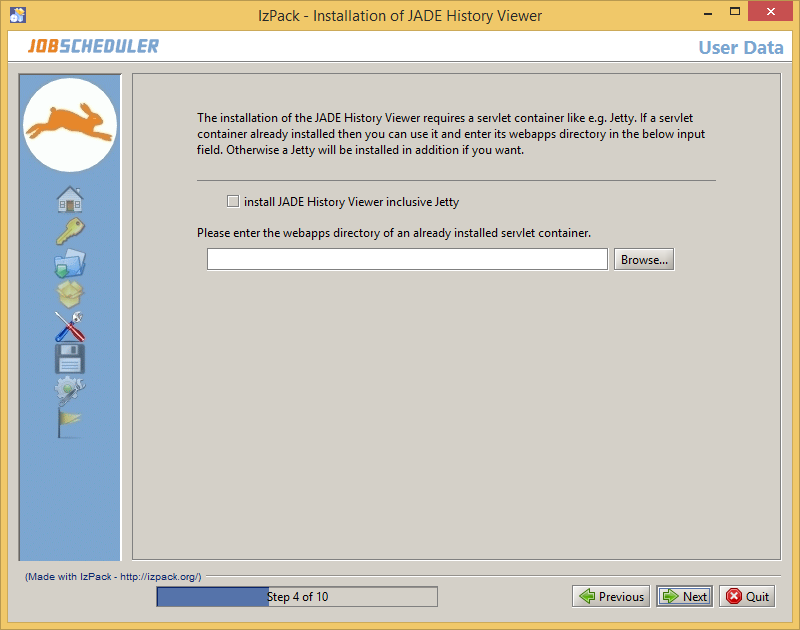Site Under Construction by Santiago Aucejo Petzoldt
Requirements
- a database connection
A database connection to the database which holds the transfer history has to be configured. - a JobScheduler with the Job Chains to fill the transfer history tables of the database (not deployed with this setup)
Installation
There are two ways to install the JADE Background Service History Viewer.
- Install the JADE Background Service History Viewer with a preconfigured jetty.
- Install the JADE Background Service History Viewer in your own webservlet container.
After selecting the install path you are prompted to decide wether you want to install the JADE Background Service History Viewer with a preconfigured jetty or to use and already installed servlet container.
Installation with a preconfigured Jetty
To install the JADE Background Service History Viewer, check the checkbox. The textfield to choose a path will disapear and a textfield to insert the port for Jetty will be shown.
Insert the port you want to use and click .
In the next step you will be prompted to choose the database you use and then to insert the credentials to the database for the database connection.
After the installation process has finished a new service is installed and active. The name of the service is "SOS JadeHistoryViewer" (Windows) or "jadehistoryviewer" (Linux) respectively.
Now you can use the JADE Background Service History Viewer with your Browser under the address http://[HOSTNAME]:[PORT]/JadeHistoryViewer.
Installation in your own webservlet container
During the installation process you will be prompted to
- configure the path to where the war file of the webapplication will be stored.
- configure the credentials for the database connection to the database holding the data of the transfer history.
The war file will be stored in the configured path and holds the configured database connection credentials.
To configure the web application in your own servlet container properly please refer to the documentation of your servlet container.
To reinstall a newer Version of the webapplication use this option, too.
Configuration Files
The war file jadeHistoryViewer.war contains some configuration files, which are updated during setup.
| Pfad | Datei | Verwendung |
|---|---|---|
| /WEB-INF/classes | log4j.properties | log4j configuration to log with log4j |
| /WEB-INF/classes | logback.xml | logback configuration to log with logback |
| /WEB-INF/classes | hibernate.cfg.xml | database configuration file |
hibernate.cfg.xml
<?xml version="1.0" encoding="UTF-8"?><!DOCTYPE hibernate-configuration PUBLIC "-//Hibernate/Hibernate Configuration DTD 3.0//EN" "http://www.hibernate.org/dtd/hibernate-configuration-3.0.dtd"> <hibernate-configuration> <session-factory> <property name="hibernate.connection.driver_class">org.mariadb.jdbc.Driver</property> <property name="hibernate.connection.password">DBPASSWORD</property> <property name="hibernate.connection.url">jdbc:mysql://DBHost:DBPort/DBName</property> <property name="hibernate.connection.username">DBUSERNAME</property> <property name="hibernate.dialect">org.hibernate.dialect.MySQLInnoDBDialect</property> <property name="hibernate.show_sql">false</property> <property name="hibernate.connection.autocommit">false</property> <property name="hibernate.format_sql">true</property> <property name="hibernate.temp.use_jdbc_metadata_defaults">false</property> <property name="javax.persistence.validation.mode">none</property> <mapping class="sos.ftphistory.db.JadeFilesDBItem"/> <mapping class="sos.ftphistory.db.JadeFilesHistoryDBItem"/> </session-factory> </hibernate-configuration>
This configuration will be updated with the credentials specified during the setup routine.
log4j.properties example
# Set the log level of the root logger to WARNlog4j.rootLogger=DEBUG, consoleAppender, fileAppender# Direct log messages to the consolelog4j.appender.consoleAppender=org.apache.log4j.ConsoleAppenderlog4j.appender.consoleAppender.layout=org.apache.log4j.PatternLayoutlog4j.appender.consoleAppender.layout.ConversionPattern=%5p [%t] (%F:%L) - %m%n# Direct log messages to a file# Set the file appender to a rolling file appender with a date configuration log4j.appender.fileAppender=org.apache.log4j.DailyRollingFileAppender# Set the type of the pattern layout to EnhancedPatternLayout to display local timezonelog4j.appender.fileAppender.layout=org.apache.log4j.EnhancedPatternLayout# Set the pattern layoutlog4j.appender.fileAppender.layout.ConversionPattern=%-5p [%d{yyyy-MM-dd HH:mm:ss,SSS Z}]: [%t] (%F:%L) - %m%n# Set the output file an its pathlog4j.appender.fileAppender.File=${PATH_SET_BY_SETUP}/JadeHistory.log# Set the append to true, should not overwritelog4j.appender.fileAppender.Append=true# Set the immediate flush to truelog4j.appender.fileAppender.ImmediateFlush=true# Set the threshold to debug modelog4j.appender.fileAppender.Threshold=debug# Set the date pattern when the rollover should happen (daily at midnight)log4j.appender.fileAppender.DatePattern='.'yyyy-MM-dd
This configuration is used for log4j logging and stores the log files to the ${PATH_SET_BY_SETUP}.
logback.xml example
<configuration debug="true"> <property name="PATH_FOR_LOGFILES" value="${PATH_SET_BY_SETUP}"/> <appender name="STDOUT" class="ch.qos.logback.core.ConsoleAppender"> <encoder> <pattern>%-5level [%d{yyyy-MM-dd HH:mm:ss.SSS}]: [%thread] %logger [%file:%line] - %msg%n</pattern> </encoder> </appender> <appender name="FILE" class="ch.qos.logback.core.rolling.RollingFileAppender"> <file>${PATH_FOR_LOGFILES}/JadeHistoryViewer.log</file> <rollingPolicy class="ch.qos.logback.core.rolling.TimeBasedRollingPolicy"> <!-- daily rollover --> <fileNamePattern>${PATH_FOR_LOGFILES}/JadeHistory.%d.log</fileNamePattern> <!-- keep 7 days' worth of history --> <maxHistory>7</maxHistory> </rollingPolicy> <encoder> <pattern>[%-5level] [%d{yyyy-MM-dd HH:mm:ss.SSS}]: [%thread] %logger [%file:%line] - %msg%n</pattern> </encoder> </appender> <root level="debug"> <appender-ref ref="STDOUT" /> <appender-ref ref="FILE"/> </root></configuration>
This configuration is used for logback logging and stores the log files to the ${PATH_SET_BY_SETUP}.


